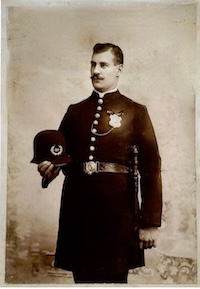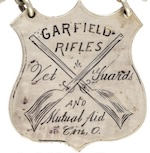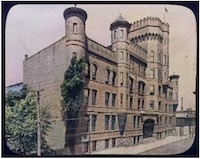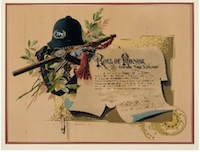Patrolman William Christian Boers, Jr. | Cincinnati Police Department
 Badge: 394
Badge: 394
Age: 44
Served: 20 years
January 20, 1897 to April 16, 1917
FAMILY
Bill’s father, William Christian Boer, Sr., at the age of 23, immigrated to the United States in 1857, likely as a result of the upheaval in Germany after the failed 1848 Rebellion. We find no account of him during his first seven years in the United States until 1863 when he was living in Cincinnati at 67 Abigail. In 1865, he was working at Hauk and Windisch’s Brewery, an occupation he would pursue for the rest of his life.
Bill’s mother, Paulene Stecher, immigrated in 1865. William, Sr., and Pauline met and married in the late 1860s. Bill was the first child born to them on June 15, 1872 in Cincinnati. In the next 12 years, four more would be added to the family: Charles W. Boers, Herman Boers, Rosa Boers, and August Christian Boers.
OFFICER
Before he was 18 or 19, Bill began working as a laborer. For the next five years he worked as a painter at a carriage manufacturing company.
- Military Service
 A month after his 18th birthday, on July 21, 1890, Bill enlisted for three years as a Private in Company D – Garfield Rifles – of the First Infantry Regiment of the Ohio National Guard. The First Infantry Regiment was disbanded by General Order No. 16 on July 8, 1891 and reorganized with nine companies by General Order No. 17 on August 15, 1891, under Colonel C. B. Hunt. A tenth Company L was organized in Middletown on April 29, 1893, but none of the companies apparently saw any action while Bill was enlisted. On July 21, 1893, at the expiration of his enlistment, Private Boers was honorably discharged. He was assessed in the discharge papers as, “Conduct excellent – a model soldier.”
A month after his 18th birthday, on July 21, 1890, Bill enlisted for three years as a Private in Company D – Garfield Rifles – of the First Infantry Regiment of the Ohio National Guard. The First Infantry Regiment was disbanded by General Order No. 16 on July 8, 1891 and reorganized with nine companies by General Order No. 17 on August 15, 1891, under Colonel C. B. Hunt. A tenth Company L was organized in Middletown on April 29, 1893, but none of the companies apparently saw any action while Bill was enlisted. On July 21, 1893, at the expiration of his enlistment, Private Boers was honorably discharged. He was assessed in the discharge papers as, “Conduct excellent – a model soldier.”
- Boers Brothers
Bill and his brothers were strapping young men, renowned for their strength and athletic ability. So, unless otherwise occupied, the three combined as a circus trio known as the Boers Brothers. Bill soon tired of traveling, but when the circus was in town, all three performed – Bill as a strongman who could hold up both brothers on his outstretched arms.
- Auxiliary Police
On February 18, 1894, about 100 unemployed ‘workingmen,’ calling themselves the Willing Workers Society, met at the Fisher and Grimm’s Hall on Vine Street to commiserate about their idled status. From the rear of those congregated, Frank Temmen called for an assault on the armory to seize guns and ammunition, hold a mass meeting of unemployed men, and march on the Mayor’s Office on February 19, 1894. He organized 27 men to conduct the raid and determined that if they were not satisfied with the mayor’s reply, they would blow up City Hall and burn the city. Cincinnati Police Superintendent Phillip Deitsch, having learned of this, with Detectives Herman Witte and R. A. Crawford, tracked Temmen down at his home, arrested him, and charged him with Inciting a Riot.
 Superintendent Deitsch then doubled the on-duty personnel in the district stationhouses. Requiring more assets and having too little time to arrange for the Governor to call up the Ohio National Guard, he arranged for volunteers to man a special detail toguard the armory. One of those was 21-year-old Bill Boers. Soon, about 20 men from the 1st Regiment (Cincinnati) of the Ohio Militia were called up to guard the armory until February 23, at which time a number of the Police Calvary took over.
Superintendent Deitsch then doubled the on-duty personnel in the district stationhouses. Requiring more assets and having too little time to arrange for the Governor to call up the Ohio National Guard, he arranged for volunteers to man a special detail toguard the armory. One of those was 21-year-old Bill Boers. Soon, about 20 men from the 1st Regiment (Cincinnati) of the Ohio Militia were called up to guard the armory until February 23, at which time a number of the Police Calvary took over.
After a trip to Ohio’s capital, Colonel Hunt returned with $50 on June 5, 1894, which was split among the fourteen volunteers that guarded the armory.
- Railroad Police
Legend has it that by 1896, Bill joined the railroad police, and that during June 1896, he single-handedly stopped and overpowered three armed bank robbers at the Eighth Street rail yards as they ran with the loot from a bank on the northwest corner of Eighth Street and Freeman Avenue. The legend furthermore credits Mayor John Caldwell, a Republican, with offering Bill, also a Republican, a job with the Cincinnati Police Department. We cannot find provenance for this occupation or incident, but it so clearly matches his past and future exploits, we do not doubt the probability.
Cincinnati Police Department
What we do know is that on July 7, 1896, six men of good reputation petitioned the Cincinnati Board of Police Commissioners nominating Bill for the position of Substitute Patrolman. He was appointed July 28, 1896, took the oath of office on August 5th, and was issued Badge 394. In short order (shorter than most), on January 12, 1897, he was promoted to regular Patrolman.
Within three months, Patrolman Boers had so impressed Superintendent of Police Philip Deitsch that Deitsch selected him to be in one of two companies that traveled to the Nashville Exposition celebrating Tennessee’s Centennial.
A year later, June 23, 1897, Patrolman Boers married Elizabeth “Lizzie” C. Kruger. With his bride, he moved from his father’s home on Central Avenue to 1779 Denham Street in Central Fairmount.
By November 1897, Patrolman Boers was working out of the Third District stationhouse on Bremen (now Republic) Street. Between then and May 1898 he was transferred to the Ninth District stationhouse (State and Dutton Streets).
Very soon thereafter, Patrolmen Boers exhibited a penchant for brave deeds that likely exceeded all other police officers throughout the history of the country. They are merely listed below but detailed in full on Boers Legend Page.
- Runaway Mule Cart
 Patrolman Boers was working in the West End at 8:30 p.m. on July 6, 1900 when the Warsaw Avenue streetcar struck a mule-draw cart driven by Morris Brown on the Eighth Street Viaduct. Brown was knocked from his cart and landed on his head. The mule bounded headlong toward pedestrians on Evans Street with three small boys inside the cart holding on for their lives. Patrolman Boers wrestled the mule to the ground saving multiple lives and earned a position on the Department’s Roll of Honor.
Patrolman Boers was working in the West End at 8:30 p.m. on July 6, 1900 when the Warsaw Avenue streetcar struck a mule-draw cart driven by Morris Brown on the Eighth Street Viaduct. Brown was knocked from his cart and landed on his head. The mule bounded headlong toward pedestrians on Evans Street with three small boys inside the cart holding on for their lives. Patrolman Boers wrestled the mule to the ground saving multiple lives and earned a position on the Department’s Roll of Honor.
- Man With a Gun
On March 3, 1901, a young man grabbed a revolver and threatened his mother. Boers responded and found the woman cowering in the corner of the room and the boy still pointing the firearm at her. Without concern for himself, Boers ran in and disarmed and arrested the son.
- Millcreek Distilling Company Fire
On May 9, 1903 there was an explosion and fire at the Millcreek Distilling Company at 1509-1511 West Sixth Street at Evans Street. Patrolman Boers single-handedly, carried a 30-foot wooden extension ladder to the building and, with the fire raging below him, climbed the ladder, rescued an employee from the third floor.
- Runaway Horse and Carriage
Less than two months later, on July 3, 1903, Patrolman Boers, off duty but still in uniform, was at West Sixth Street and Central Avenue which was crowded with pedestrians shopping at the Sixth Street Market. An out-of-control horse, attached to a light runabout, dashed up Central Avenue from Fifth Street toward the shoppers. Patrolman Boers leaped into the street and seized the horse’s bridle and was dragged nearly to his death but saved the citizens in the area.
- Saves a Child
Sixteen days later, on Sunday, July 19, 1903, about 10 p.m., a woman and her five children were standing at the edge of the streetcar tracks in front of a large crowd of people at the end of the Sedamsville Streetcar Line. An electric car came along and one of the children stepped out in front of it and froze. The motorman saw the child and tried to stop the car, but it looked for a moment like the child would be crushed to death. Patrolman Boers saw the child and the approaching streetcar, again risking his own life, jumped in front of the moving car, grabbed the child, and leaped off the tracks just in time for the fender of the car to catch the child’s dress, tearing it.
- Department’s Strongest
On September 24, 1903, the Cincinnati Post reported that Patrolmen Boers and James Connor might, at the Department’s Annual Inspection, have a contest of strength to determine which is the strongest. To date, Night Chief of Police Samuel Corbin had been considered to hold the title. We have no indication whether or not the contest was held, but thereafter Patrolman Boers was consistently called the “strongman of the Department.”
- Another Child and Streetcar Incident

On July 10, 1904, Patrolman Boers was in the front seat of a streetcar as it sped down State Avenue when 2½-year-old Violet Hitchens toddled into the street to the middle of the streetcar tracks on Gest Street. Quick as a flash, Boers climbed under the railing on the inside of the car, ran a few paces with the car, and threw himself directly into the path of the car, grabbed the child, and threw her outside the danger zone. Boers was dragged underneath for 20 feet until the car could be stopped. For that he was awarded one of only five Alms Medals for Valor ever issued.
- Another Man with a Gun
Fourteen days later, on July 24, 1904, Sallie Preston called the Ninth Street Station to report that a man, Charles McWilliams, pointed a gun at her and her husband at 672 Evans Street. Boers responded. Upon seeing him, McWilliams ran from the house and dove into ragweed in The Bottoms. Disregarding the danger, Boers pursued him into the ragweed. Zigzagging in and out and doubling back on his tracks, McWilliams finally escaped, only to be arrested the next day.
- Wild Woman with a Knife
Almost two weeks later, on August 5, 1904, Patrolmen Boers and Lammert came across John Garrett and Mable Johnson arguing at 6th and Delhi Streets. Johnson pulled out a knife and slashed Garrett’s coat. Boers jumped into the fray and the woman, slashing wildly, sliced Boers’ hand, nearly severing one of his fingers.
Attack Dog
On June 29, 1908, when he and Patrolman Ottoway arrested a dozen men at 1012 Taylor Alley who were shooting craps, and Ottoway went to call for a wagon, one of those arrested sicced an attack dog on Boers. The club in Boers’ massive right hand came down atop the poor dog’s head, crushing his skull and killing him.
- Another Fire Rescue
On June 14, 1909, an arsonist started a fire in the basement of a tenement house at 827 West Sixth Street and it quickly burned through the vacant first floor trapping several individuals on the second and third floors. The Fire Department responded with sufficient ladders but too few personnel to affect enough rescues. Patrolman Boers took one of the ladders, climbed to the second floor, entered a smoke-filled apartment while the fire blazed below him, and found a woman and carried her down the ladder to safety.
- Another Man with a Gun
On July 22, 1909, a citizen reported to Patrolman Boers that a man was killing his wife at 717 West Fifth Street. He rushed to the house where he heard the woman screaming. As he approached, a giant of a man, Henry Dodson drew a gun and yelled, “If you come in here, I’ll kill you!” Boers went in and in a desperate fight, during which “guns were drawn, and pieces of furniture were used as weapons,” the two giants fought while the wife barred the door, preventing any assistance from outside. Patrolman Boers overpowered Dodson and arrested both the man and his wife.
- Yet Another Gun
On January 23, 1910, a woman came up to Patrolman Boers at night and told him that John Foster of 325 John Street had threatened her with a pistol. Boers found Foster at Fourth and John Streets with a fully loaded and primed revolver. We have no details of the arrest, but the article mentions that the revolver was so large that those attending court gasped.
- Final Man with a Gun
By 1917, Patrolman Boers and his family were living at 1746 Pulte Street. On April 13, 1917, 15-year-old Evelyn Boers dreamed that her father would be murdered. She did not reveal this to her mother, but she cried all day at school and her teacher and classmates were unable to console her.
On the night of April 16, 1917, Mrs. Margaret Jones, a Fourth District character known as “Hi-Ball Meg,” came to the stationhouse and appealed to Desk Sergeant John Lemmick for protection from her husband, Frank C. Jones, and told the sergeant that he was armed with a gun. Sergeant Lemmick dispatched Patrolman George W. Kaderli who was just coming on duty. Though going off duty, Patrolman Boers told Kaderli that he would go with him because he knew Jones and could calm him down. Patrolman Boers and Jones were members of the Loyal Order of Moose, Junior Order of Maccabees.
When they got to 834 West Fourth Street, Patrolman Boers, said, “I’ll go in and see if I can quiet Frank.” Mrs. Jones walked in with him.
Jones was standing at the kitchen doorway and as Patrolman Boers approached, Jones raised a revolver and shot twice. One round hit Boers in the pit of his stomach and the other went wild. It was Mrs. Jones’ impression that her husband was shooting at her. Patrolman Boers pushed Mrs. Jones to safety, yelling, “Look out, Margaret, he’s after you! He got me, but don’t let him shoot you.”
Kaderli pursued Jones, firing at him, and Jones leaped from a second-floor window to Sweeney Alley, breaking his left ankle. Kaderli easily apprehended the hobbled Jones and found two revolvers on him.
Both Patrolman Boers and Jones were transported to General Hospital. At the hospital, Patrolman Boers gave a statement that he was shot by Jones as he entered the hallway. He said Jones opened a door leading to the hallway, saw his wife and the officer, and shot him. He also said, “I intended only to quiet him, not arrest him.”
- Ma, I tried it once too often.
Doctor J. Stewart Hagen said that when told that his wounds were not survivable, Patrolman Boers calmly prepared for the end. With his wife and daughters at his side, he directed disposal of his personal effects. His son William (17) was with friends and could not be found in time. He told his wife, “I want William to have my medal for bravery.”
Then he told her, “Ma, I tried it once too often. This time they got me.” Those were his last words.
DEATH
Patrolman Boers died at 10:30 p.m. on April 16, 1917 at General Hospital from a gunshot injury of the descending aorta (abdominal). It was the fourth murder of a Cincinnati officer in three years.
Pallbearers, including Patrolmen Elmer Lotshaw, Frank Mueller, Frank Kruse, and George W. Kaderli, reported at 1:30 p.m., on April 19, 1917 to Patrolman Boers’ residence at 1746 Pulte Street. Company E and Color Guard reported to Linden and Pulte Streets at 1:40 p.m. wearing blue helmets, winter blouses, winter trousers, white gloves, and tassels on batons. Chief of Police William Copelan and Police Inspectors Dennis Ryan and Michael Kane also accompanied the coffin. Funeral services were held at 2 p.m. at his late residence, 1746 Pulte Street and were presided over by Reverend Henry J. Sonneborn. Patrolman Boers was buried in the German Protestant Cemetery, Walnut Hills, with military honors. Cincinnati Police Company E and the Color Guard served as the escort of honor along with Smittie’s Band. Police personnel were directed to wear the mourning badge for four days, April 16 through 19. He was buried with military honors.
JUSTICE
After the shooting, Jones told police, “I don’t know why I shot Bill. We were fellow lodge members, and he has always been my friend.”
Coroner Arthur C. Bauer held an inquest on April 19, 1917. Neighbors reported that before the officers responded to the Jones’s home, he had already fired shots into the air. Some asserted that he was suffering from alcoholic delusions. Others said he knew what he was doing. Mrs. Jones asserted her right to not testify against her husband. Jones was still in the hospital. On April 27thCoroner Bauer ruled that Jones was sane at the time of the murder even though some witnesses said he was intoxicated.
Jones appeared in Police Court for a Preliminary Hearing on May 11, 1917 and was bound over to the Grand Jury by Municipal Judge Meredith Yeatman and held without bond. He was represented by William Thorndyke and did not testify.
On June 23, 1917, the Hamilton County Grand Jury released an indictment for Jones for 2nd Degree Murder. On June 26, 1917, he appeared before Judge Robert Z. Buchwalter in the Criminal Division of the Court of Common Pleas and entered a plea of not guilty. He was released after posting a bond of $2000 (over $51,000 in 2023). A trial was set before Judge Alfred K. Nippert for December 3, 1917.
Jones left town, he failed to appear for the trial, his bond was forfeited, and a warrant was issued for his arrest. Safety Director Walter J. Friedlander was indignant, asserting, “The police department was not consulted before Jones was released on bond. A system which permits a man who kills a police officer in cold blood to be released on a small bond, thereby affording an opportunity to escape, is an outrage!”
The fugitive’s freedom was brief. Hamilton County Sheriff George F. Schott, with the assistance of Government authorities, surveilled his mail and traced him to Memphis, Tennessee. Police there arrested him on January 18, 1918. Chief Deputy John Wenner sent Deputy Sheriff John Connelly to Memphis to return Jones to Cincinnati.
For the trial, officers of the court included William Thorndyke and Robert A. Kramer for the defense and Prosecuting Attorney L. H. Capelle and Assistant Prosecuting Attorney C. H. Elston for the State. On February 4, 1918, Thorndyke attacked the indictment asserting that there was no law affixing the number of people in a grand jury. Judge Wade Cushing dismissed the motion and ordered the trial continued. Jones then, on February 7th, claimed “mental irresponsibility” and was examined by Dr. Ralph Reed, alienist. That ploy did not work either. Late that night, the jury came back with a quick verdict of guilty of Second-Degree Murder. The judge complimented the jury on a just verdict.
On February 12, 1918, ten months after the murder, Judge Cushing sentenced Jones to life imprisonment. On June 8, 1918, his wife filed for divorce. The divorce was granted July 31, 1918.
Already, ten months after his conviction for cold blooded murder of a policeman, during December 1918, a rumor circulated that Democrat Governor James M. Cox intended to pardon Jones. Policemen in Cincinnati protested this inane intention, reminding the governor that nine of their fellow members had died in the line of duty in the previous five years. Cox quietly deferred.
After appeals by Thorndyke, the Ohio Court of Appeals affirmed Jones’s life sentence on January 20, 1919.
Still, Jones would not serve his due. After serving 13 years, on November 15, 1930, he was paroled from the Ohio State Penitentiary with a promise (and condition for his parole) that he would refrain from drinking. Seven months later, on June 22, 1931, Cincinnati Patrolmen Clifford Beckner and Gus Seifert arrested an intoxicated Jones and three intoxicated women after a disturbance of loud noise and breaking dishes in the apartment of Lillian Hardy at 943 Clark Street. Jones assaulted Patrolman Beckner and the women joined in the affray. On the way to Central Station, Patrolman Frank Jackson was assaulted and the antenna on the police radio was destroyed. When Jones’ identity was revealed at Central Station, he became abusive and threatened to “kill another white cap” – referring to the Cincinnati officers who wore white caps at the time. He specifically threatened to “get” Lieutenant Williams Adams when released. Municipal Judge George E. Tebbs sentenced him to 30 days in the workhouse and his case was handed over to the parole officer for investigation. He was apparently returned to the Ohio Penitentiary.
One year later, on July 14, 1932, the Ohio Parole Board announced that they were paroling Jones on July 24, 1932, with the condition that he leave the state.
We believe that he violated that parole also. A Frank Jones was paroled in 1940 but have been unable to assert that it was the same man.
EPILOGUE
All of Patrolman Boers’s children died without issue.
Patrolman Boers’s second cousin and contemporary, Edward William Hughes, while in the United States Navy and aboard the U.S.S. Benning when a boiler exploded, exhibited incredible bravery in saving the lives of sailors, and was awarded the Congressional Medal of Honor. Some say bravery at that level is in the blood.
If you know of information, artifacts, archives, or images regarding this officer or incident, please contact the Greater Cincinnati Police Museum at Memorial@Police-Museum.org.
This narrative was revised December 16, 2023 by Cincinnati Police Lieutenant Stephen R. Kramer (Retired), Greater Cincinnati Police Historical Society President. All rights are reserved to him and the Greater Cincinnati Police Museum.